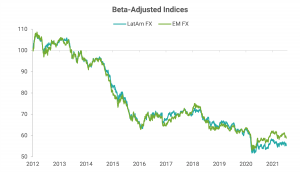Resumo do Relatório
FX Dashboard: Is it Time for Latin American Currencies to Turn Around?
The US 10y yield rallied further to reach 1.3% this morning, a level where it was last in mid-February. The US dollar (DXY Index), meanwhile, continues to hover around the recent highs of 92.5. Whether the release later today of the minutes from the June FOMC meeting – when the Fed surprised with a hawkish pivot – changes the direction of either remains to be seen. Our baseline view, as we highlighted in the note yesterday, is one of lower rates volatility over the next couple of months, which may support a “carry trade” environment.
If we are entering or already in a carry trade environment, then within emerging markets, Latin American currencies look interesting. As the chart below shows, they have underperformed the broad EM FX complex since the start of the pandemic. Could LatAm currencies make up for some of their underperformance if vols stay low over the coming weeks?

Data Source: Refinitiv; Note: LatAm FX and EM FX = equally weighted index of spot returns of 5 and 22 currencies, respectively
To address this question, let’s first look at the main drivers behind the underperformance:
- Monetary policy and carry:
- In a note last week, we made the case that monetary policy has been the most important driver behind the recent performance of EM currencies. Indeed, one of the reasons for the underperformance of LatAm currencies has been their low carry relative to their volatilities – see the chart below. However, this is changing.
- The Brazilian real (BRL) is the one LatAm currency that has performed well since March end when the US 10y yield peaked (see here). One of the main drivers behind BRL’s turnaround has been the aggressive monetary tightening by the central bank.
- Mexico’s central bank surprised with a hike last month, and the minutes from the last MPC meeting in Chile indicated that the central bank discussed raising rates.
- Both Peru and Colombia have so far resisted providing any hawkish signals as they are dealing with growth uncertainties resulting from the rise in political noise and low vaccination rates. With inflation rising, however, it is only a matter of time before both make a policy shift towards tightening. The curves in all the LatAm countries are pricing in interest rate hikes in excess of 100 bp over the next 6 months.
- In other words, while the LatAm currencies are at or below the regression line in the chart below, on a prospective basis the carry for these currencies is on the rise. However, for the laggards to turn around, the necessary condition maybe for the respective central banks to spell out their intent to raise rates.

Data Source: Refinitiv; Note: EM = equally weighted index of 22 currencies
- Politics and fiscal deterioration:
- In the above-mentioned note on BRL, we outlined one of the reasons behind the currency’s recent outperformance is the mitigation of fiscal concerns and political turmoil. While this is likely to be temporary as we head into the presidential election next year, the window was sufficient for BRL to outperform.
- In the case of Mexico, recent political developments can be characterized as net positive as President AMLO’s Morena party lost its supermajority in the lower chamber in the June elections, lowering the risk of any market-unfriendly legislative changes.
- The Peruvian sol (PEN) has been the worst-performing currency in EM this year on a beta-adjusted basis on concerns regarding the policies of the leftist president-elect (although yet to be confirmed) Pedro Castillo. While the jury is still out, our view is that the fears are overdone and at the very least already in the price to a great extent. Castillo’s economic advisors are credible, and he has requested the central bank president, Julio Velarde, to stay in his post. Also, his party, Peru Libre, lacks a majority in Congress with only 37 out of 130 seats, making the likelihood of extreme policy moves low.
- Chile is headed to a presidential election in November in which a leftist candidate, Daniel Jadue, currently leads in the polls. Moreover, the process to draft a new constitution has started with less than a third of the members of the constitutional assembly from right-leaning parties. From a glass-half-full perspective, Jadue has the highest rejection rate, making it difficult for him to win in a potential second-round runoff, and the constitution will take up to a year to write followed by a national plebiscite.
- Colombia faces a presidential election next year and similar to the shifts in other countries, a leftist candidate, Gustavo Petro, is currently in the lead in polls. However, similar to Jadue in Chile, his rejection rate is very high. Also, the median rating downgrade to sub-investment grade because of the lack of fiscal consolidation has already materialized for foreign-currency debt and, as we have highlighted previously, it is less likely for local debt. As such, the downgrade risk is behind.
For Chile, Peru, and Colombia, a shift in monetary policy may thus provide a near-term window for the currency to perform, especially with copper prices stabilizing which should help the Chilean peso (CLP) and PEN. The political risks should not be underestimated but with LatAm FX volatility coming off the highs towards its long-term average (see the chart below), some of the risks appear to be in the price already.
We currently have long recommendations for CLP and the Mexican peso (MXN) (see here and here) and would look for signals from the respective central banks to make similar recommendations in Peru and Colombia.

Data Source: Refinitiv; Note: LatAm FX and EM FX = equally weighted index of spot returns of 5 and 22 currencies, respectively
Best Longs / Best Shorts
- The list of underperformers based on our models in the attached FX Dashboard stayed unchanged with the Peruvian sol (PEN), the Philippine peso (PHP), and the Thai baht (THB) on it.
- From the list of outperformers, we removed the Hungarian forint against the euro (EURHUF) as its z-score receded.
- The list now has BRL and the Taiwan dollar (TWD) on it.
Best Crosses
- The list of preferred relative-value trades based on our models changed to Short BRL vs Long PEN or CLP or COP or THB or PHP.
- The 3m expected returns for these pairs are high in the range of 10.5-15.5% (not annualized), assuming mean reversion.
Aviso legal
DISCLAIMER: Este Relatório de Análise foi elaborado e distribuído pelo Analista, signatário unicamente para uso do destinatário original, de acordo com todas as exigências previstas na Resolução CVM nº 20 de 26 de fevereiro de 2021 e tem como objetivo fornecer informações que possam auxiliar o investidor a tomar sua própria decisão de investimento, não constituindo qualquer tipo de oferta ou solicitação de compra e/ou venda de qualquer produto. As decisões de investimentos e estratégias financeiras devem ser realizadas pelo próprio leitor, os Analistas, ou a OHMRESEARCH não se responsabilizam por elas. Os produtos apresentados neste relatório podem não ser adequados para todos os tipos de investidores. Antes de qualquer decisão de investimentos, os investidores deverão realizar o processo de suitability no agente de distribuição de sua confiança e confirmar se os produtos apresentados são indicados para o seu perfil de investidor. A rentabilidade de produtos financeiros pode apresentar variações e seu preço ou valor pode aumentar ou diminuir num curto espaço de tempo. Os desempenhos anteriores não são necessariamente indicativos de resultados futuros. A rentabilidade divulgada não é líquida de impostos. As informações presentes neste material são baseadas em simulações e os resultados reais poderão ser significativamente diferentes.
O(s) signatário(s) deste relatório declara(m) que as recomendações refletem única e exclusivamente suas análises e opiniões pessoais, que foram produzidas de forma totalmente independente e que a OHMRESEARCH não tem qualquer gerência sobre este conteúdo. As opiniões aqui expressas estão sujeitas a modificações sem aviso prévio em decorrência de alterações nas condições de mercado. O Analista responsável pelo conteúdo deste relatório e pelo cumprimento da Resolução CVM nº 20/21 está indicado acima, sendo que, caso constem a indicação de mais um analista no relatório, o responsável será o primeiro analista credenciado a ser mencionado no relatório. Os analistas cadastrados na OHMRESEARCH estão obrigados ao cumprimento de todas as regras previstas no Código de Conduta da APIMEC para o Analista de Valores Mobiliários e no Manual de Controles Internos para Elaboração e Publicação de Relatórios da OHMRESEARCH. De acordo com o art. 21 da Resolução CVM nº 20/21 caso o Analista esteja em situação que possa afetar a imparcialidade do relatório ou que configure ou possa configurar conflito de interesse, este fato deverá estar explicitado no campo “Conflitos de Interesse” deste relatório.
O conteúdo deste relatório é de propriedade única do Analista signatário e não pode ser copiado, reproduzido ou distribuído, no todo ou em parte, a terceiros, sem prévia e expressa autorização deste Analista. Todas as informações utilizadas neste documento foram redigidas com base em informações públicas, de fontes consideradas fidedignas. Embora tenham sido tomadas todas as medidas razoáveis para assegurar que as informações aqui contidas não são incertas ou equívocas no momento de sua publicação, o Analista não responde pela veracidade das informações do conteúdo.
Para maiores informações, pode-se ler a Resolução CVM nº 20/21 e o Código de Conduta da APIMEC para o Analista de Valores Mobiliários. Este relatório é destinado exclusivamente ao assinante da OHMRESEARCH que o contratou. A sua reprodução ou distribuição não autorizada, sob qualquer forma, no todo ou em parte, implicará em sanções cíveis e criminais cabíveis, incluindo a obrigação de reparação de todas as perdas e danos causados, nos termos da Lei nº 9.610/98 e de outras aplicáveis.





